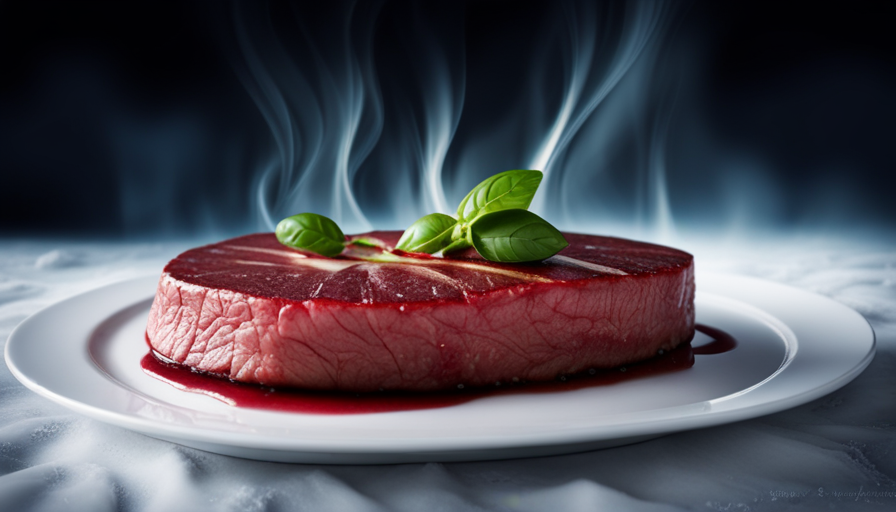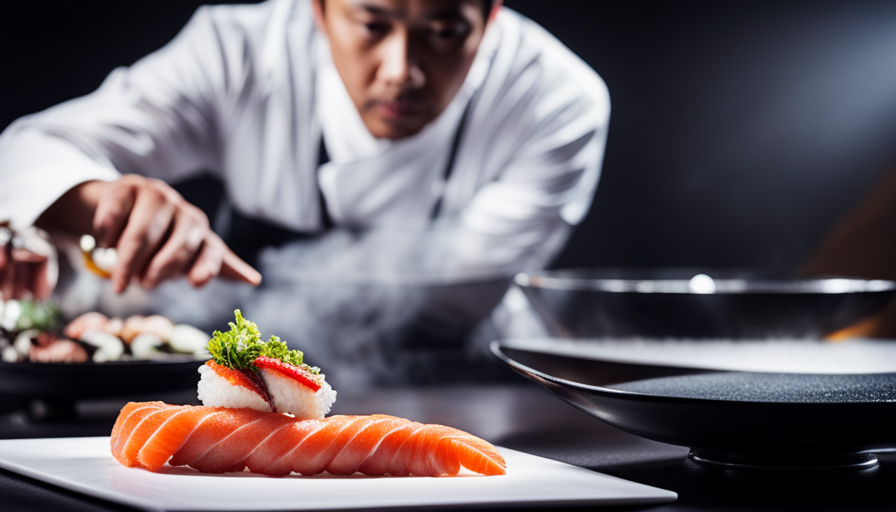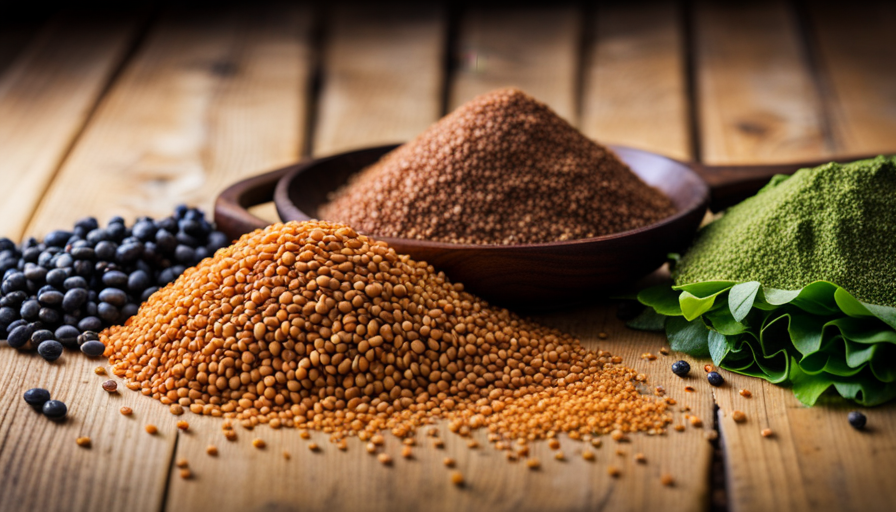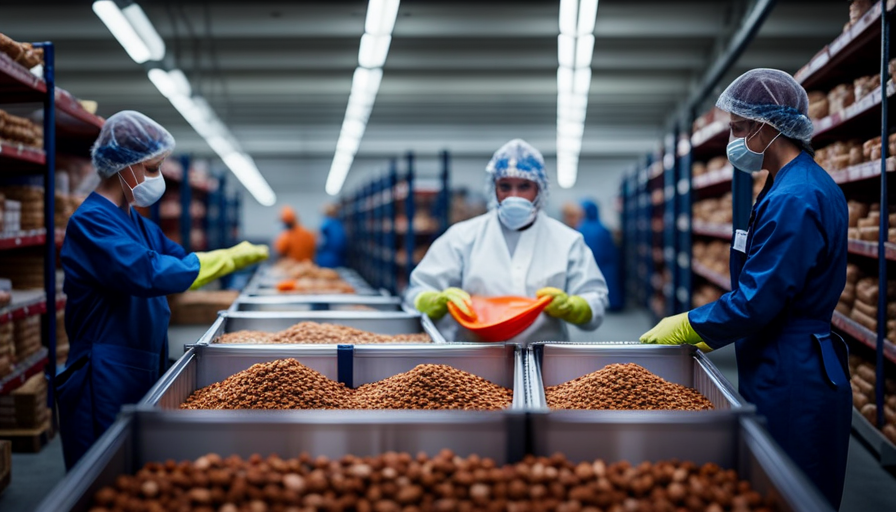“You know the old saying: ‘You are what you eat.’ When it comes to raw steak, this saying holds a deeper significance.”
As a food safety expert, I can tell you that consuming undercooked or raw meat carries certain risks, including the potential for food poisoning. But just how common is it to get food poisoning from raw steak?
In this article, we’ll delve into the world of foodborne illnesses and explore the prevalence of food poisoning cases specifically related to raw steak. We’ll also discuss the factors that contribute to the occurrence of food poisoning and highlight the safe cooking temperatures for steak.
By understanding the risks and taking necessary precautions, you can greatly reduce the likelihood of experiencing food poisoning from raw steak. So, let’s dive in and make informed decisions about our steak consumption to ensure our health and well-being.
Key Takeaways
- Consuming undercooked or raw steak can lead to food poisoning due to the presence of harmful bacteria.
- The prevalence of food poisoning cases from raw steak is significant, highlighting the importance of proper handling and cooking.
- Following safe cooking temperatures and techniques, such as using a food thermometer and avoiding cross-contamination, can help prevent food poisoning from raw steak.
- Making informed choices, such as purchasing high-quality meat from reputable sources and understanding the potential health risks, can minimize the risk of foodborne illnesses associated with raw steak.
The Risks of Consuming Raw or Undercooked Meat
Consuming raw or undercooked meat can be extremely dangerous as it puts you at a high risk of getting food poisoning. It’s important to understand the risks associated with consuming raw or undercooked meat and to take precautions to ensure safe cooking techniques.
Raw or undercooked meat can contain harmful bacteria such as Salmonella, E. coli, and Campylobacter. These bacteria can cause severe food poisoning, leading to symptoms like nausea, vomiting, diarrhea, and abdominal pain. In some cases, food poisoning can be life-threatening, especially for individuals with weakened immune systems, young children, and the elderly.
To minimize the risk of food poisoning, it’s crucial to cook meat thoroughly. This means ensuring that the internal temperature reaches a safe level to kill any bacteria present. Using a food thermometer can help you accurately determine the doneness of the meat. The USDA recommends cooking steak to a minimum internal temperature of 145°F (63°C) for medium-rare and 160°F (71°C) for medium.
Understanding foodborne illnesses and the importance of safe cooking techniques is essential in preventing food poisoning. By taking the necessary precautions and cooking meat properly, you can greatly reduce the risk of getting sick.
Moving forward, let’s delve into the different types of foodborne illnesses and how they can be prevented.
Understanding Foodborne Illnesses
When it comes to consuming raw or undercooked meat, it’s important to be aware of the risks associated with it. One of the main concerns is the presence of certain bacteria in raw steak, such as E. coli and Salmonella. These bacteria can cause food poisoning. The symptoms of food poisoning can range from mild to severe and may include nausea, vomiting, diarrhea, abdominal pain, and fever.
Types of Bacteria Found in Raw Steak
If you’re not careful with raw steak, you could end up with a bad case of food poisoning due to the presence of various types of bacteria.
Raw steak is known to contain several types of pathogens, including Escherichia coli (E. coli), Salmonella, and Campylobacter. These bacteria can cause serious illnesses when ingested.
To minimize the risk of food poisoning, it’s important to handle and cook raw steak properly. Here are three important factors to consider:
-
Cooking methods: Ensure that raw steak is cooked to the appropriate internal temperature to kill any harmful bacteria. Using a meat thermometer can help you determine when the steak is cooked thoroughly.
-
Cross-contamination: Avoid cross-contamination by keeping raw steak separate from other foods, utensils, and surfaces to prevent the spread of bacteria.
-
Storage: Properly store raw steak in the refrigerator or freezer to inhibit bacterial growth.
Understanding the types of bacteria found in raw steak and following safe cooking practices can help prevent food poisoning.
Now, let’s delve into the symptoms of food poisoning.
Symptoms of Food Poisoning
To protect yourself, be aware of the symptoms that can arise from mishandling and undercooking your steak. Food poisoning can result from consuming raw or undercooked steak contaminated with bacteria such as E. coli, Salmonella, and Campylobacter. These bacteria can cause a range of symptoms, including nausea, vomiting, diarrhea, abdominal pain, and fever. In more severe cases, food poisoning can lead to dehydration and even organ damage. If you experience these symptoms after consuming raw steak, it is important to seek medical attention. Treatment options for food poisoning include staying hydrated, resting, and taking over-the-counter medications to relieve symptoms. However, it is crucial to note that the long-term effects of food poisoning can vary depending on the individual and the severity of the illness. Moving on to the next section, the prevalence of food poisoning cases from raw steak…
Prevalence of Food Poisoning Cases from Raw Steak
Raw steak can be a recipe for disaster, as it’s not uncommon to get a taste of food poisoning from this juicy temptation. The prevalence of bacterial contamination in raw steak is a significant factor contributing to food poisoning cases.
Bacteria like E. coli, Salmonella, and Campylobacter can be present in raw meat, especially if it has been contaminated during processing, transportation, or handling. These bacteria can cause severe gastrointestinal symptoms such as nausea, vomiting, diarrhea, and abdominal pain.
Improper storage also plays a role in the prevalence of food poisoning cases from raw steak. When raw steak is not stored at the proper temperature, bacteria can multiply rapidly, increasing the risk of contamination. It is crucial to store raw steak in the refrigerator at a temperature below 40°F (4°C) and to consume it within a few days to minimize the growth of harmful bacteria.
Factors that contribute to food poisoning extend beyond bacterial contamination and improper storage. Cross-contamination, such as using the same cutting board or utensils for raw meat and other foods without proper cleaning, can also lead to foodborne illness. Additionally, undercooking the steak and not practicing proper hand hygiene while handling raw meat can increase the risk of food poisoning.
In the next section, we will explore these factors in more detail to understand how to prevent food poisoning from raw steak.
Factors that Contribute to Food Poisoning
Watch out for the factors that can lead to a stomach-churning experience when enjoying a juicy steak. Food poisoning from raw steak can be caused by several factors contributing to the contamination of the meat. It’s important to be aware of these factors to ensure your safety and prevent any unpleasant consequences.
-
Cross-contamination: One of the main factors contributing to food poisoning is cross-contamination. If raw steak comes into contact with other foods, utensils, or surfaces that are contaminated with harmful bacteria, it can lead to illness when consumed.
-
Improper storage: Another factor is improper storage of raw steak. If the meat isn’t stored at the correct temperature, bacteria can multiply rapidly, increasing the risk of food poisoning.
-
Inadequate cooking: Cooking steak to the appropriate temperature is crucial in killing any harmful bacteria present. Undercooking the meat can leave bacteria alive and cause illness when consumed.
-
Lack of adherence to food safety regulations: Failure to follow proper food safety regulations can greatly increase the risk of food poisoning from raw steak. This includes not properly cleaning and sanitizing utensils and surfaces, as well as not practicing good hygiene.
By being aware of these factors and taking the necessary precautions, you can greatly reduce the risk of food poisoning from raw steak. Make sure to stay tuned for the next section on safe cooking temperatures for steak.
Safe Cooking Temperatures for Steak
Ensure a mouthwatering and safe dining experience by mastering the art of cooking steak to the perfect temperature that will have you savoring each juicy bite. To achieve this, it’s essential to follow safe cooking techniques and pay attention to recommended cooking times. This not only enhances the flavor and texture of the steak but also eliminates any potential risks of food poisoning.
To help you cook your steak to perfection, refer to the table below for safe cooking temperatures:
| Steak Doneness | Internal Temperature |
|---|---|
| Rare | 125°F – 130°F |
| Medium Rare | 130°F – 135°F |
| Medium | 135°F – 145°F |
It’s crucial to use a meat thermometer to ensure the steak reaches the desired temperature accurately. Remember, these temperatures are recommended by food safety experts to kill any harmful bacteria that may be present in raw meat.
By following these safe cooking temperatures, you can enjoy a delicious steak while minimizing the risk of foodborne illnesses. In the next section, we will delve into the best practices for handling and cooking raw steak, ensuring you have all the knowledge necessary to create a delectable and safe dining experience.
Best Practices for Handling and Cooking Raw Steak
Mastering the art of cooking steak to the perfect temperature allows you to create a mouthwatering dining experience that’ll have you savoring each juicy bite.
When it comes to handling and cooking raw steak, there are a few best practices to keep in mind. First and foremost, choosing the right seasoning is key. A simple blend of salt, pepper, and garlic powder can enhance the natural flavors of the steak without overpowering it.
Additionally, different cuts of steak require different cooking methods. For tender cuts like filet mignon, a quick sear in a hot skillet followed by finishing in the oven is recommended. For thicker cuts like ribeye or strip steak, a reverse sear method works best, where the steak is cooked in a low oven first and then finished with a sear. These methods ensure that the steak is cooked to perfection, with a juicy and tender interior and a flavorful crust.
Moving on to the next section about reducing the risk of food poisoning, it’s important to take certain precautions when handling and cooking raw steak.
Reducing the Risk of Food Poisoning
When it comes to reducing the risk of food poisoning, there are two key points that I want to discuss. First, by purchasing high-quality meat from a reputable source, you can ensure that it has been handled and stored properly, reducing the risk of contamination. Second, using a food thermometer to properly cook your meat to the recommended internal temperature will help kill any harmful bacteria that may be present.
Additionally, make sure to wash your hands thoroughly before and after handling raw meat, and avoid cross-contamination by using separate cutting boards and utensils for raw and cooked foods.
Purchasing High-Quality Meat
If you’re looking to savor the juiciest and most tender steak, finding a reliable source for purchasing high-quality meat is key. Here are some tips to help you choose the best meat for your next meal:
-
Purchasing organic meat: Opting for organic meat ensures that the animals were raised without the use of antibiotics, hormones, or genetically modified feed. This can reduce the risk of contamination and provide a healthier option.
-
Benefits of grass-fed beef: Grass-fed beef isn’t just more flavorful but also contains higher levels of omega-3 fatty acids and antioxidants. It’s also leaner and lower in unhealthy fats compared to conventionally raised beef.
-
Look for marbling: Marbling refers to the small streaks of fat within the meat. This adds flavor, moisture, and tenderness to the steak.
-
Check for a bright red color: High-quality meat should have a vibrant, bright red color. Avoid meat that appears dull or grayish.
-
Trustworthy sources: Purchase meat from reputable suppliers or local farmers who prioritize animal welfare and quality.
When it comes to ensuring your steak’s safe to eat, using a food thermometer is essential.
Using a Food Thermometer
When it comes to ensuring the safety of your meat, purchasing high-quality cuts is just the first step. To further minimize the risk of foodborne illnesses, it’s crucial to employ proper cooking techniques.
One effective way to do this is by using a food thermometer. By inserting the thermometer into the thickest part of the steak, you can accurately gauge its internal temperature. This is especially important when cooking steaks to a desired level of doneness, as undercooked meat can harbor harmful bacteria.
Following food safety guidelines and cooking your steak to the recommended internal temperature will help eliminate any potential pathogens and reduce the risk of food poisoning.
Now, let’s move on to the next section, where we’ll explore the importance of personal hygiene in preventing foodborne illnesses.
The Importance of Personal Hygiene
Handwashing techniques and avoiding cross-contamination in the kitchen are two key points when it comes to the importance of personal hygiene. As someone who’s studied food safety extensively, I can confidently say that proper handwashing is crucial in preventing the spread of harmful bacteria.
Additionally, being mindful of cross-contamination, such as using separate cutting boards for raw meat and produce, is essential to maintain a safe and sanitary kitchen environment.
Handwashing Techniques
To avoid any unwanted surprises, make sure you scrub your hands clean like a surgeon preparing for a delicate operation before handling that juicy raw steak. Proper handwashing techniques are crucial when it comes to maintaining personal hygiene in the kitchen. It is important to use warm water and soap, and to scrub your hands for at least 20 seconds, making sure to clean all surfaces, including between the fingers and under the nails. To ensure you are washing your hands effectively, refer to the table below for a step-by-step guide:
| Handwashing Technique |
|---|
| Wet your hands with warm water |
| Apply enough soap to cover all surfaces |
| Rub your hands together vigorously |
| Rinse your hands thoroughly under running water |
Following these handwashing techniques will help reduce the risk of food poisoning from raw steak and other contaminants. Now, let’s discuss how to avoid cross-contamination in the kitchen.
Avoiding Cross-Contamination in the Kitchen
To keep your kitchen a safe haven for culinary creations, it’s essential to master the art of avoiding cross-contamination like a skilled maestro conducting a symphony of flavors. Preventing cross-contamination is crucial in ensuring the safety of your food.
One of the key ways to achieve this is through proper storage techniques. It’s important to store raw meats, like steak, separately from other foods to prevent any potential bacteria from spreading. This can be done by using separate cutting boards and utensils for raw meats and other ingredients.
Additionally, make sure to properly clean and sanitize all surfaces and tools after handling raw meats. By following these practices, you can greatly reduce the risk of foodborne illnesses caused by cross-contamination.
Now, let’s dive into the world of food safety regulations and inspections.
Food Safety Regulations and Inspections
Although regulations and inspections play a crucial role in ensuring food safety, it’s worth exploring how common it is to contract food poisoning from consuming raw steak.
Food safety regulations are put in place to protect consumers from potential health risks associated with the consumption of raw or undercooked foods, including steak. These regulations establish guidelines for handling, storing, and preparing food in order to prevent cross-contamination and the growth of harmful bacteria.
Food inspections are an essential part of the regulatory process. Inspectors visit food establishments to assess their compliance with food safety regulations and ensure that proper hygiene practices are followed. They check for cleanliness, proper storage and handling of food, and the maintenance of appropriate temperatures during cooking and storage. Inspections help identify potential risks and provide an opportunity for corrective actions to be taken.
To better understand the risks of food poisoning from raw steak, it’s important to consider the following:
-
Proper cooking: Cooking steak to the recommended internal temperature of 145°F (63°C) can help kill harmful bacteria.
-
Safe handling: Properly storing and handling raw steak can minimize the risk of contamination.
-
Quality sourcing: Choosing reputable suppliers and ensuring the freshness of the steak can reduce the chances of foodborne illness.
By being aware of food safety regulations and following proper cooking and handling practices, consumers can make informed decisions about consuming raw steak. This will help minimize the risk of foodborne illness and ensure a safe and enjoyable dining experience.
Transitioning into the conclusion, it is crucial to understand the potential risks associated with raw steak consumption and make informed choices to protect our health.
Conclusion: Making Informed Decisions about Raw Steak Consumption
Now that we’ve discussed the regulations and inspections that ensure food safety, let’s draw some conclusions about making informed decisions regarding the consumption of raw steak.
As a knowledgeable and authoritative source, I can provide you with important information about the health implications of consuming raw steak.
Raw steak, like any other raw meat, carries a risk of foodborne illnesses such as food poisoning. While the chances of getting food poisoning from raw steak are relatively low, it’s not an entirely risk-free option. The bacteria that can be present in raw meat, such as E. coli or salmonella, can cause severe gastrointestinal symptoms if not properly cooked.
To minimize these health risks, it’s crucial to handle and cook raw steak with care. First and foremost, always make sure to purchase your meat from a reputable source that follows proper regulations and inspections. Additionally, ensure that the steak is stored and handled at the correct temperatures to prevent bacterial growth.
When consuming raw steak, it’s important to be aware of the potential health implications and make an informed choice based on your personal preferences and tolerance for risk. If you decide to consume raw steak, ensure that it’s of high quality and properly prepared to minimize the risk of foodborne illnesses.
By understanding the potential health risks and taking necessary precautions, you can make informed choices regarding the consumption of raw steak while prioritizing your health and well-being.
Frequently Asked Questions
How long does it take for symptoms of food poisoning from raw steak to appear?
The incubation period for food poisoning from raw steak can vary, but it typically ranges from 1 to 48 hours. During this time, early symptoms may start to appear. These can include nausea, vomiting, stomach cramps, and diarrhea.
It’s important to note that the severity of symptoms can vary from person to person. If you experience these symptoms after consuming raw steak, it’s crucial to seek medical attention immediately.
Can you get food poisoning from eating rare or medium-rare steak?
Food poisoning from rare or medium-rare steak is uncommon. In fact, according to a study conducted by the Centers for Disease Control and Prevention, the risk of getting sick from properly cooked steak is very low. Consuming steak cooked to these temperatures can actually have health benefits, as it retains more nutrients and flavor.
To ensure safety, it’s important to purchase high-quality meat, handle it properly, and cook it at the right temperature.
What are the most common types of bacteria found in raw steak that can cause food poisoning?
Bacterial contamination in raw steak can lead to food poisoning. The most common types of bacteria found in raw steak are Escherichia coli (E. coli) and Salmonella. These bacteria can cause severe gastrointestinal symptoms such as nausea, vomiting, and diarrhea.
To prevent food poisoning, it’s crucial to handle and cook raw steak properly. This includes storing it at the correct temperature, avoiding cross-contamination, and cooking it to the recommended internal temperature.
Are there any specific groups of people who are more susceptible to getting food poisoning from raw steak?
Individuals who are more susceptible to food poisoning from raw steak include pregnant women, young children, older adults, and people with weakened immune systems. According to a study conducted by the Centers for Disease Control and Prevention (CDC), pregnant women are 10 times more likely to get sick from a certain type of bacteria found in raw steak.
This highlights the importance of proper handling and cooking of raw steak, especially for those in vulnerable populations, to minimize the risk of foodborne illnesses.
Can marinating raw steak help to kill bacteria and reduce the risk of food poisoning?
Marinating raw steak can indeed provide several benefits. It not only enhances the flavor but can also help kill bacteria and reduce the risk of food poisoning. However, it’s important to note that marinating alone may not be sufficient to completely eliminate all harmful bacteria. Proper handling and storage of raw steak are crucial in preventing bacterial contamination. This includes keeping the steak refrigerated, separate from other foods, and cooking it thoroughly to kill any remaining bacteria.
Is it Safe to Eat Raw Potatoes Without Risking Food Poisoning from Raw Steak?
While eating potatoes raw on a vegan diet is safe, it’s not recommended to consume raw steak due to the risk of food poisoning. Raw potatoes do contain certain toxins, but the levels are generally low and safe for consumption in moderation. However, raw steak poses a higher risk of foodborne illness.
Conclusion
In conclusion, it’s crucial for individuals to exercise caution when considering the consumption of raw or undercooked steak. While it isn’t a common occurrence, the risk of food poisoning from such practices isn’t to be taken lightly. Understanding the prevalence of foodborne illnesses and the contributing factors can help us make informed decisions.
By adhering to safe cooking temperatures and practicing proper personal hygiene, we can significantly reduce the risk of falling victim to food poisoning. It’s important to prioritize food safety regulations and inspections for a healthier dining experience.










